What would happen if the development, running and all the activities associated with a major art center were guided by an energy budget and not just by a financial one? If, in accordance with the Paris Agreement, that cultural space were to cut its energy use by 50%? And how uncomfortable would that be for museum workers and art lovers?
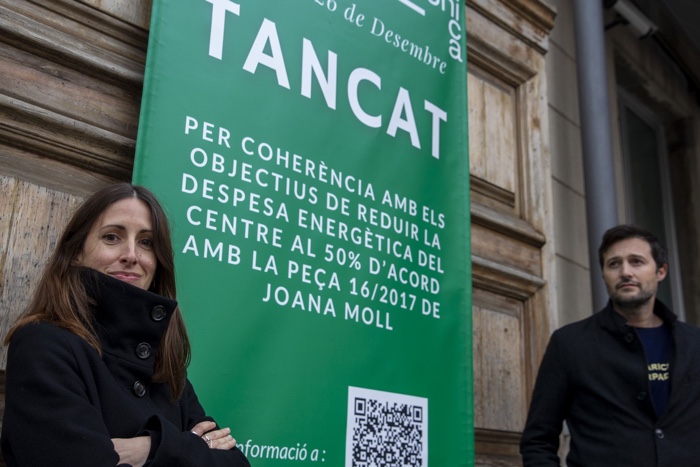
Joana Moll and Enric Puig Punyet, the director of Arts Santa Mònica in front of a poster that announces the temporary closure of the art centre. Photo: Joan Sánchez
That is exactly the kind of questions Joana Moll wanted to investigate with 16/2017, a project that challenged the Centre d’Arts Santa Mònica in Barcelona to halve its energy expenditure during a four months-long collective exhibition titled Exposar · No exposar-se · Exposar-se · No exposar / To Exhibit- · Not to Expose · To Expose · Not to Exhibit.
16/2017 is named after a law approved by the government of Catalunya in 2017, which, among other things, obliges governments to work with carbon budgets in order to cut in half their Co2 emissions by 2030.
Drastically reducing the energy expenditure of Santa Mònica involved turning off or reducing the daily air conditioning hours both in the exhibition space and in the offices, having days during which the staff switched on and off the lights according to the presence of visitors in the space, slashing the number of flights taken by guests of the centre, etc.
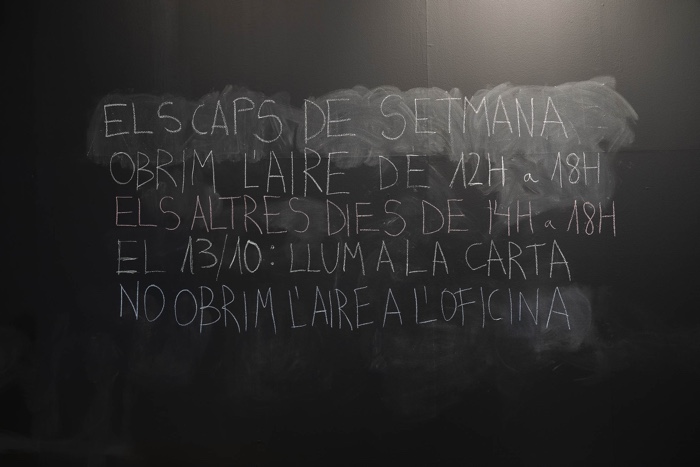
The text above reads: “During the weekends, we open the air conditioning from 12h to 18h. The other days from 14h to 18h. On the 13th of October: lightening a la carte. We don’t open the air conditioning in the office.” At the exhibition Exposar, no exposar-se, exposar-se, no exposar / Expose · Do not expose · Expose · Do not expose, at Arts Santa Mònica. Photo: © Jordi Play
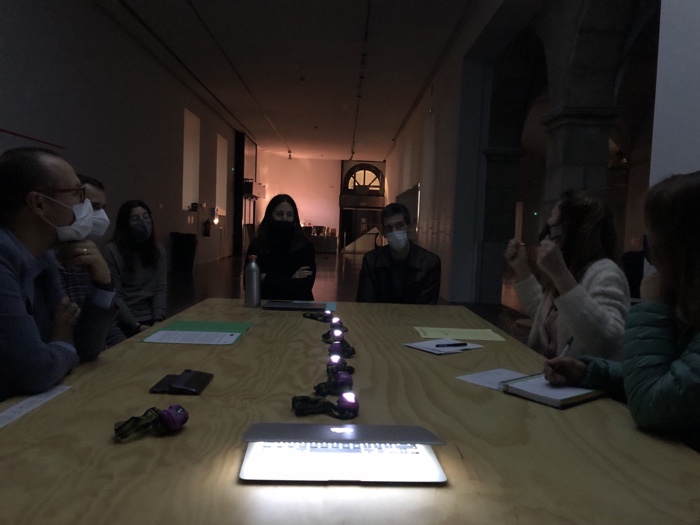
Joana Moll, 16/2017, 2021. Photo courtesy of the artist
Furthermore, members of the management team of the museum and all the agents involved in the exhibition were invited to participate in public negotiation tables (where they were advised to “come with warm clothes, a charged phone and, if possible, a torch”) to discuss the measures that needed to be adopted in order to respect the energy budget.
A few days before the closing of the exhibition, realising that the energy budget might overrun, Moll and the direction of the art centre agreed to close Santa Mònica for a week, from December 20 to 26. This decision was motivated by the need to save enough energy in the middle of Winter and ensure comfortable climatic conditions for both workers and visitors when the centre reopened.
The 16/2017 experiment suggests that in order to face the climate emergency, it is no longer enough for cultural institutions to present works with critical content, they should also lead the way in adopting new behavioural and structural changes. Art has raised awareness around environmental concerns for many years. Now is the time to step up, provoke changes and inspire new practices, mindsets and solutions that can have tangible effects on our carbon footprint.
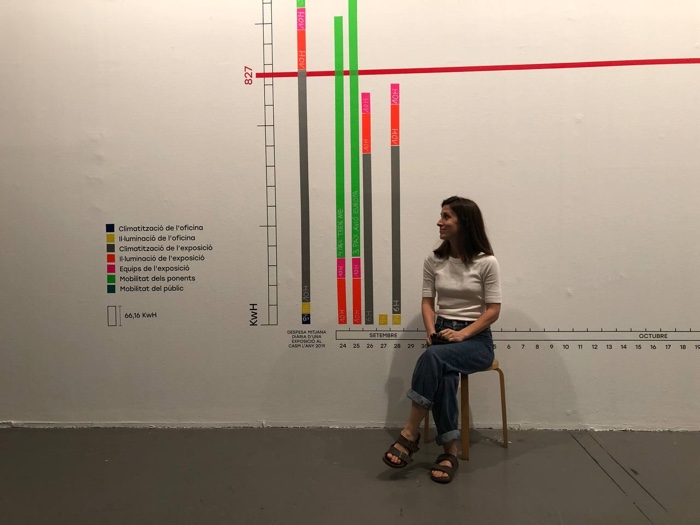
Joana Moll, 16/2017, 2021. Photo courtesy of the artist
I’m very happy that Joana Moll found a moment to answer my many questions about the 16/2017 project:
Hi Joana! Could you discuss the graphics that make visible the energy expenditures of the Centre? How has it evolved over the course of the exhibition?
In order to control and regulate the energy of Arts Santa Mònica, we had to split the energy expenditure of the building and its activities into several parts. The engineers that developed this study, Inèdit Innova, agreed that the best way to calculate and regulate energy expenditure was to cut it down to seven different blocks: climatization of the exhibition, the hardware used by the exhibition, lighting of the exhibition, climatization of the offices, lighting of the offices, guests and visitors. This system was crucial to understanding the distribution of energy among these blocks and thus helped us control it better.
The graphic had a total length of 108 days (which equaled the length that the exhibition 16/2017 was part of). The graph showed the number of hours that each specific block was activated every day, together with their corresponding amount of kWh. For example, it showed that on day 20, the air conditioning was opened for just 1 hour, and this represented an estimated 94 kWh, while the exhibition lighting was opened for 5h and it used 80 kWh. In the case of the visitors and guests, the graph showed the number of visitors and guests that came every day and the type of transportation they used and their equivalences in energy wasted. Besides, the graphic also showed whether a particular day the limit set by the energy budget was respected or not, so the public could understand the different sets of decisions that made the daily budget lower or higher.
The graphics that accompany the piece were designed not just to make the energy expenditure of the Centre visible, but to keep track and expose the set of decisions that were taken day by day. We felt this was particularly important, as at the end of the day, the energy saved, or not, was a direct consequence of the decisions that the several stakeholders of Arts Santa Mònica took, and we wanted this to be as transparent and as available as possible to the general public.
The objective of reducing energy consumption by 50% compared to the budget established by an exhibition developed under normal conditions has been achieved.
The most notable applied measures were: reduction of the opening hours of the air conditioning during the weeks with milder temperatures; complete turn off the air conditioning of the offices from the beginning to the end of the exhibition; closure of the exhibition for one week.
Moreover, it has exceeded the target, saving 9.5% of the budget (8,512 kWh). The economic savings have been more than € 7,000, although it may vary depending on the price of the kWh applied. In this case, 0.25€/kWh has been taken into account, an approximate price per kWh in Spain at the end of 2021. On the other hand, by comparing the available electricity bills for 2019 and 2021 by Arts Santa Mònica, we observe that there has been a saving in electricity consumption of around 25% in the last months of the year.
The project involved regular meetings around a negotiation table. Everyone involved in the exhibition was invited to join the discussions. I suspect there were some frictions. What were the points more difficult to agree on? Cutting down on flights? Turning off the air conditioning?
As we already mentioned, several measures were taken such as: limiting the use of air conditioning in the exhibition space and in the offices, opening and turning off the lights according to the spaces that visitors transit or reducing the number of trips of the speakers of the programming parallel to the exhibition, among others. In addition, the tables have incorporated the participation of various actors in the scientific, political and cultural field of the city of Barcelona to generate debates focused on the need to develop new social contracts to fight against climate change, and the essential role of culture to facilitate it.
I remember there was a particularly complicated meeting. The exhibition personnel, whose main tasks included taking care of the visitors and doing guided tours, joined the meeting and they said that, by law, we could not lower or increase the temperature of the building beyond a certain threshold to allow them to work in proper conditions. That meant that we could not shut down the air conditioning or the heating as we pleased. This ended up in a really interesting conversation on whether we should privilege workers’ rights or nature. In the end, the personnel agreed that the proposal was necessary for the political message that it sent, so they agreed on shutting down the air for a few hours, but not for the whole day.
It is upsetting to realize the carbon footprint of contemporary art and the impact it has on energy consumption. Were you expecting it to be so bad? Did you and the Center hope that you would be able to meet the initial objective of reducing the energy expenditure of the center by 50%?
Honestly, I had no idea what to expect. I do try to calculate the footprint of my projects as much as I can, but I’ve never tried to do this with a whole exhibition before. We were very positive about meeting the 50% reduction at the beginning, but then we started to realize that it would not be that easy despite the efforts carried out by the direction and the personnel of the center, precisely because we could not shut down the air or heating completely, as the workers would have suffered the consequences more than anybody else.
The problem here is that most of the museums are not designed to exist sustainably, so even if you try to apply sustainable measures it will be very hard for the institution to adapt to it. In that sense, there’s a need for a fundamental change, and I believe it is urgent.
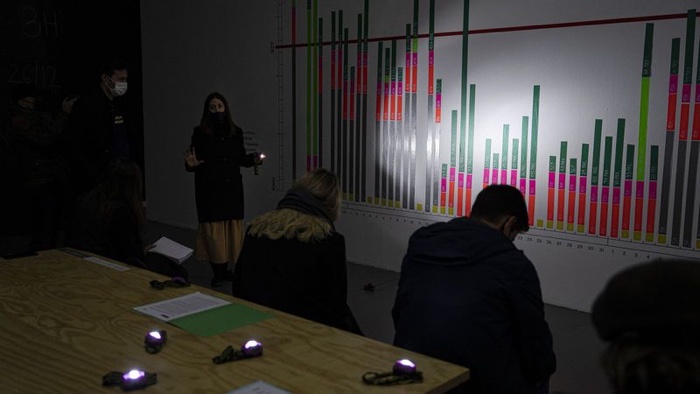
Joana Moll, 16/2017, 2021. Photo: Joan Sánchez
I was surprised that, in front of this impossibility to slash the energy consumption by 50%, the Centre d’Arts Santa Mònica would be brave and coherent enough to close down the exhibition 6 days before it ended. I really admire their integrity. How difficult was it to discuss that possibility and reach a decision?
I think this was an incredibly brave decision as well! I wanted to do this from the very beginning, but the director, Enric Puig, said that he’d try to avoid this decision as much as possible. But then we hosted a negotiation table with high profile public servants from the culture department of the government of Catalonia, which ultimately is the body that supervises Arts Santa Mònica. During the table, we discussed the need to bring culture at the forefront of the fight against climate change, as global warming is asking us to radically change the way we engage with the world, and that’s essentially a cultural matter. However, politicians heavily rely on science to solve climate change (actually they are waiting for a tech messiah that will swallow CO2 and expel dollars in return), and thus relegate culture at the end of the line. They simply don’t get it, which I believe it’s ridiculous and dangerous. Thus, closing the museum did not just help us get closer to our goal of halving the energy expenditure of the Centre, but sent a strong political message on the essential role of culture in addressing climate change.
As far as I know, 16/2017 was an innovative experiment so I suspect that you and the museum team encountered some unexpected challenges and learned how to deal with them along the way. What were the most surprising discoveries that emerged during those 4 months?
I had this project in mind for a long time, well, not exactly this, but the idea of regulating the energy consumption of an exhibition was something that I was interested in. So when Enric proposed to me to develop a new commissioned piece for this exhibition I immediately threw this idea on the table, and he agreed straight away (which really surprised me!) The problem was that when I tried to land it from an abstract form to a concrete shape I felt it was too complicated. Arts Santa Mònica production team said that we’d need a complex technical display to make this possible, and I ditched the idea. Then, after a few days I realized that I got myself trapped into this dominant narrative of science & tech being the only way to address climate change. So, I called Enric and I said that we didn’t need any technical display to regulate the energy consumption of the building, that the piece was not about that, but about radically changing our relationship with the building, the exhibition space and the people that were part of it.
Another interesting discovery was the fact that most of the personnel at Santa Mònica did not know how to turn on and off the air conditioning, the lighting and anything that had to do with energy. They had absolutely no connection with the energy source that allowed the institution to exist in the first place, and I thought that this was problematic, as it is probably quite usual in this kind of space (and elsewhere…).
Finally, the idea of hosting negotiation tables was something that was not so important at the beginning, but it gained more and more relevance as the piece evolved, until it became the most crucial part of the whole performance. This was largely due to the influence of Maria Farràs, whom I hired to help me design the mediation aspects of the piece, such as the display of the graphic, and the communication of the project in general. Maria said it would be really interesting to involve not just the different stakeholders directly involved with the Centre, but other parties belonging to the cultural tissue of the city. Then we expanded this idea by including politicians and climate change experts on the same table where cultural agents would be present, to nurture a very necessary debate on the role of culture and global warming. So we developed a specific programme where we had local guests coming from the cultural and scientific communities of the city together with Arts Santa Mònica personnel. The discussions were vibrant!!
Currently, we are editing a publication that contains the transcripts of all the conversations that took place within the negotiation roundtables. We hope that it will see the light after the summer, and we are planning to make it available online.
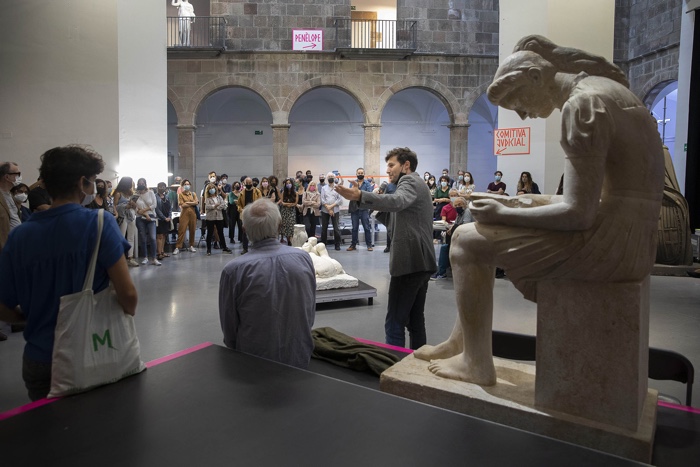
Opening of the exhibion Exposar, no exposar-se, exposar-se, no exposar / Expose · Do not expose · Expose · Do not expose, at Arts Santa Mònica. Photo: Jordi Play
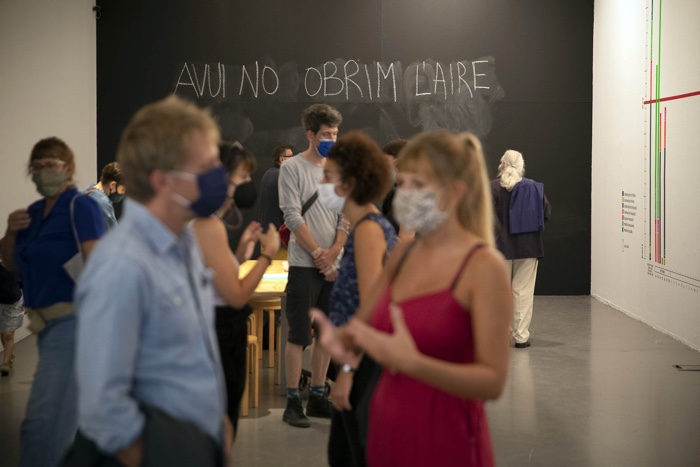
Opening of the exhibion Exposar, no exposar-se, exposar-se, no exposar / Expose · Do not expose · Expose · Do not expose, at Arts Santa Mònica. Photo: Jordi Play
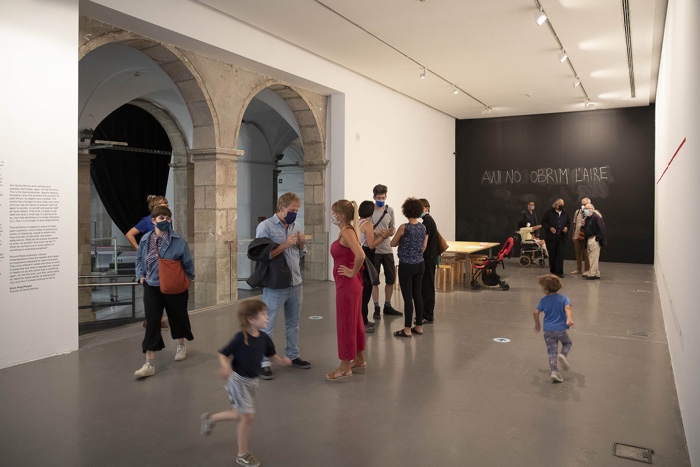
Opening of the exhibion Exposar, no exposar-se, exposar-se, no exposar / Expose · Do not expose · Expose · Do not expose, at Arts Santa Mònica. Photo: Jordi Play
How much did the work affect the comfort and experience of visitors? And how understanding were they of the discomfort produced by dim lighting or by the absence of air conditioning in the summer and heating in the winter?
The exhibition opened in mid-September, a period usually quite warm in Barcelona. That day we decided to close the air conditioning on purpose. The opening was quite packed, so obviously, most of the people were sweating, and complaining, but it was worth it. Besides, I never thought that one of my projects would materialize in the sweat of its public…!
We did not receive a direct complaint from the visitors, most of them really enjoyed it. However, some of the exhibition personnel complained about the temperature of the room during the winter, which I understand. To make their day-to-day more comfortable we decided to close one of the access doors to the building to prevent the natural airflow and keep the spot where they usually receive the public, warmer.
Will 16/2017 leave traces on the future daily activities of the Centre d’Arts Santa Mònica and influence its functioning and the way it will conceive its programme?
Are you planning to organise other iterations of the experiments in other art centres?
I’d love to iterate the project. Maria and I managed to pack the project quite nicely, and taking into account the particularities of a given place, it’s a project that can be easily reproduced. It gave great results at Arts Santa Mònica, especially when it came to changing the way the Centre’s workers think about sustainable practices and their role in implementing them. Marina, the head of production, said that every time she sees an old bulb or an artist asks her for a specific material, hardware, she immediately thinks of the energy consumption of these objects and requests, which is something that she never thought about before 16/2017. I think this is the biggest success of the project, being able to change the way people relate to energy and actually doing something about it. I believe this is something that it’s not going to fade away easily and it is indeed important to apply it elsewhere. In more general terms, even though lowering the energy consumption of the museum was a collective effort, it would not have been possible without the complicity of the director and the management board.
Thanks Joana!
The collaborators on 16/2017 were Maria Farràs, Oriol Gayán and Inèdit Innova (Jordi Olivé and Anna Aymerich)
Previously: Critical investigation into the politics of the interface. An interview with Joana Moll, Covid-19 might not follow us online but our carbon footprint does, Exploitation Forensics. Interview with Vladan Joler, etc.
